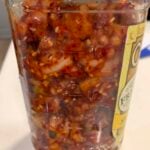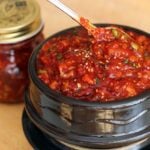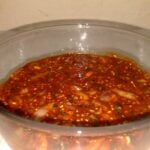I sometimes feel like eating a small morsel of fermented seafood with rice. That’s Korean jeotgal, salty preserved seafood. It tastes salty, chewy, garlicky, gingery, and sweet with a deep, fermented, almost nutty flavor. Today I’m again introducing you to one of my favorite mitbanchan (preserved side dishes that can be refrigerated for a long time). It’s spicy fermented squid jeotgal called ojingeojeot.
Korea is surrounded by ocean on 3 sides, so you can imagine that a variety of fresh fish and seafood dishes are available all year round. My Korean ancestors wanted to enjoy their fresh fish for a long time so they developed a way to preserve them in salt. This jeotgal can be eaten later with rice and other side dishes, or it could be used in kimchi making, too. It’s mostly made with seafood such as anchovies, shrimp, small yellow corvina, or pollock’s intestine, etc.
Among all the different kinds of jeotgal, this ojingeojeot made with squid is my favorite because it’s very easy to make and squid is available pretty much everywhere, fresh or frozen. I use frozen here in New York City because fresh squid is hard to find.
Ingredients
Makes 1 pound of ojngeojeot
- 1 pound cleaned squid (See the video for how to clean squid)
- 3 tablespoons Kosher salt

for the seasoning paste:
- ⅓ cup gochu-garu (Korean hot pepper flakes)
- ⅓ cup rice syrup (or corn syrup)
- 1 teaspoon fish sauce
- 2 green onions, chopped
- 3 garlic cloves, minced
- 1 teaspoon peeled ginger, minced
- 2 green chili peppers, stems removed, deseeded, and chopped
- 1 tablespoon toasted sesame seeds
- 2 teaspoons toasted sesame oil
Directions
Ferment squid:
- In a bowl, mix the squid and the salt, then put it into a glass jar or an airtight container.
- Cover and refrigerate. Let it ferment for 1 month. Mix it up every week or two by turning the jar upside down, so the salty water mixes with the squid. Put it back into the fridge right side up.
 (1 month old fermented squid on the left, fresh salted squid on the right)
(1 month old fermented squid on the left, fresh salted squid on the right) - After 1 month take the squid out of the jar and rinse it in cold running water to remove any excess salt. Drain and dry it out with paper towels.

- Peel the skin off. It can be slippery so I usually use paper towels to get a grip.

- Cut into strips, chop the squid into small pieces, and then gently pound with your knife to soften it. Set aside.


Make seasoning paste:
- Combine hot pepper flakes, rice syrup, fish sauce, green onion, garlic, ginger, and green chili pepper in a large bowl.
- Mix well with a spoon.
Put it together:
Maangchi's Amazon picks for this recipe
It's always best to buy Korean items at your local Korean grocery store, but I know that's not always possible so I chose these products on Amazon that are good quality. See more about how these items were chosen.























































Bonjour Maangchi ! Testée beaucoup de fois et délicieux tout le temps ! Alors j’ai voulu “créer “! J’ai fait le même assaisonnement avec de la morue dessalée et voici le résultat en photo ! Je vous conseille cette recette car c’était délicieux … avec du riz bien sûr sûr. Bisous de France, Paris. Cindy
See full size image
Biiiiiiiiig failure here !
I don’t know what happened but I couldn’t achieve the recipe because the squid turned unusuable even if it wasn’t spoiled.
It standed 5 weeks in the fridge with salt.
When I opened the jar to wash it, the smell was agreable, it smelled as in a good fish shop.
I tasted it after peeling and washing and it turned too much salty with an awful texture (the external part was really tough and the meat itself was mushy and slippery).
I washed it again and again and again and…again… the water was never clean and I saw that the meat was vanishing little by little. At the end only the tough part remained, as a thin tough and translucid skin.
The squid and the salt were good quality…I really don’t know what happened but it must be the amount of salt.
Anyway, I have to do it again and be patient.
As you see in the recipe, fermenting squid is very simple and needs only 2 ingredients: squid and salt. You need good quality squid and proper amount of salt but you said, “The squid and the salt were good quality” Then I think the issue is amount of salt.
Salt will make the squid ferment without going bad. Add more salt. The amount of salt in the recipe is the least amount that I developed. Follow the recipe tightly or add more salt if you want.
I’m sure you will make nice oijingeojeot later.
Hi, I fermented the squid for 1 month, and made the dish. However, the squid is not as crunchy as the one I bought outside. Is there anything I can improve on?
Maangchi. J’admire et adore votre site mais vous ne répondez plus aux commentaires. … que ce passe-t-il? ???
Helo evlibodi,
I just made this dish.
After 1 m fermentation it still smells like a fresh squid. I’m not sure, if 1 m was enough. And it’s still very salty, after washing it several times. And it was bubbling while washing, is it usual?
I don’t dare to eat it
But I love maangchis kimchi a lot
Bonjour. Pareil que vous mais j’ai poursuivi la recette (avec moins de tous ces piments!!!) Et c’est surprenant, bizarre mais finalement très bon sur du riz ou vermicelles BRULANT pour cuire le calamar. Bon appétit ✌
Hello Maangchi,
I have a question regarding to this recipe:
First, can I substitute the octopus for the squid?
Second, if I chop the octopus or the squid into small pieces when putting the salt in, can I reduce the time for fermentation down to 1 or 2 weeks?
Thanks a lot, and I look forward to your reply . :D
Bonsoir. Comme pas de réponse, je me permets ! Pieuvre ou calamar peu importe mais bien décortiquer et nettoyer. Après même si coupé en tout petit c’est 1 mois de fermentation, pas moins! Vous allez voir c’est délicieux
Well – or rather not:
Our fishmonger closes this Saturday… :-(
Are the 750 grams before or after cleaning? I managed to buy some today, already cleaned and skinned (eyes and barks are a minor issue)…
Bye, Sanne.
I’ve kept that treasure in my near-freezing cold fridge ever since – and opened it (GOOD&GOOD) only today to make mak-kimchi.
https://www.maangchi.Com/recipe/easy-kimchi
Perfectly OK; smells like Sardellenpaste (a paste common here in Germany when I was a child; made with anchovies and salt), still crunchy.
Love you, Maangchi! ❤️❤️❤️
Hi Maangchi,
Need help on recipe close to the fermented squid, my kids like fry fish but then its just plain,
something with spicy/nonspicy with vegetables with nice looking red color sauce to it would it possible i you could come up with this??? Hope to hear from you. Thank you very much.
Regards,
Adrian
Dear Maangchi
Ever since I found your blog and youtube video I have been a massive fan and so hooked by your recipes!
I am a Japanese born Korean and have been living in London for over 20 years.
Although I had no chance to learn how to cook Korean food from my mother my memories and my tongue remember how good my mother’s cooking was and I am so proud of being a Korean having both culture Korean, Japanese and British.
And I love cooking myself too.
Anyway… I have a question about this squid dish.
Should these squid be very fresh ‘Sashimi’ level of quality?
It is said you could use frozen, which I imagined they are not needed to be ‘Sashimi’ quality as they will be fermented…
I will try and get as fresh as possible in London, however finding ‘sashimi’ quality may be a little difficult.
Hope you could kindly get back to me sometime :)
Thank you.
Tomo
Hi Maangchi
I have a question about the fermented squid.
I live in Singapore, a tropical country.
I followed the steps to do the fermented squid and would like to check with you is there a minimum time to ferment the squid. I left the squid in the freezer (as it colder of course). Can it be like 2 weeks? I’m so greedy and I can’t wait to eat it!
Looking forward to hear from you soon!
All I can say to you is to be patient. You need to ferment it at least 1 month. Good luck with fermenting salty squid! : )
Hi Maangchi,
I have just finished making my 1st batch of the squid. It actually have a very strong after taste. The fermented squid has a very strong odor and taste even after several wash. The aftertaste is still very strong even after adding the paste. I’m not sure if something went wrong during the fermenting process. How do I know if the squid is being fermented properly?
Thank you for all your lovely recipes. I have been trying out a lot of your recipes and it has been a huge success. Looking forward to hear from u soon :)
Hello Maangchi!
Thanks for the lovely recipe. I have made the dish twice, but unfortunately did not ferment the squid for a full month both times. Fortunately, however, it turned out delicious both times. I have just made almost 2kg of it, hopefully it will last me while the next batch of squid ferments for the one month it is supposed to. I am Malaysian, you see, and it is very hard to find this dish where I live. I discovered ojingeojeot at a shop near where I used to live in another state, and I was immediately hooked. That’s why I couldn’t wait for the squid to fully ferment, I was too greedy! I had to substitute corn syrup with cane sugar and I also added chilli padi to the dish because I love it crazy spicy, but otherwise I’ve followed your recipe to the letter. Except,for the fermenting period, again. I am so glad you posted the recipe. I can’t thank you enough! Here’s a pic of my ojingeojeot, I am very proud of it!
See full size image
Your ojingeojeot looks fantastic! yummy!
Hi Maangchi! I know I am not posting this in the right place, but I have a question about a recipe in your book. I am trying to make salted fermented sardines. My fishmonger cleaned them for me. Should I wait and get whole sardines and use these for something else, or will gutted/cleaned sardines work for the fermented fish?
Oh my, you are making it! Great!
I never remove the guts and heads when I make it. But gutted and cleaned sardines should work, too. Good luck!
Maangchi,
Do you know how to make “Nakji jutgal”? I mean Spicy Pickled Octopus. Can I use the same way here? Please share with us.
Thanks,
Rafe
Hi Maangchi
I live in Calgary now and I don’t always have chance to find the some of the ingredient I am looking for because the store is not big enough to carry that many kind of good. I really like your cooking show and the dishes you made. I am Chinese, grew up in Canada. We have very similar culture. Your food is so easy for me to learn, probably. I would like to try this fermented squid side dish. How long will they be good to stay in the fridge? After I made this dish and how many days should I wait in order to consume?